C.S. Burrough's Blog
November 13, 2025
My review of The House of Mitford, by Jonathan Guinness with Catherine Guinness
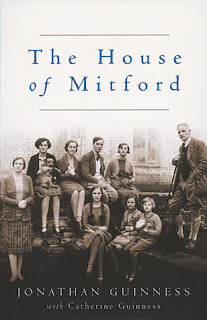
After this sitting considerably far down my Mitford history reading list, I was taken by its erudition. My expectations were cynical, knowing it was penned by family insiders: author Jonathon Guinness, 3rd Baron Moyne, is the eldest son of Diana Mosley (née Mitford) by her first husband Bryan Guinness; his co-author is his daughter the Hon. Catherine Guinness. My tainted expectations could not have been wider off the mark.
Not only is there a marked absence of family bias, but the wordsmithing outshines every Mitford biography I have read. He does his forebears proud, his craftsmanship a testament to this clever bloodline. His being schooled at Eton and Oxford, one might expect this standard, but others with similar academic foundations have produced less impressive works.
I did not find, as certain readers have implied, any pro-Conservative slant to the narrative (the author was a Conservative Party Parliamentary Candidate). Wary of rightwing undertones, I here found objectivity from start to finish. Graced with impartiality, the content may stop short of censuring history's political right, which is not tantamount to partisanship.
I did sense, in certain of Jonathon Guinness's references to his novelist aunt Nancy Mitford, subtle retributory tones on behalf of his mother Diana who spent most of WWII in prison partly thanks to Nancy. That history, well documented by all Mitford biographers, goes like this:
After leaving her first husband for British Union of Fascists leader Sir Oswald Mosley, Diana spent time in Germany with Hitler and his inner-circle in the prelude to WWII, aiming for a Nazi-approved radio station for the BUF which never eventuated. When Mosely was imprisoned early in the war under 18B as a potentially dangerous person, Diana was initially left to do much of his bidding on the outside. Nancy was summoned by MI5 to comment on how 'dangerous' she thought her younger sister. Putting patriotic duty before blood, Nancy said she thought Diana 'highly dangerous', swaying the government's decision to lock up Diana too. Separated from her babies, Diana was accordingly detained without charge or trial for years, subject to the horrors of Holloway Jail. Diana never learned of this sisterly betrayal until late in life and Mosley never learned of it.
So, one could understand any tinge of injustice felt on his mother's behalf by this author, who as a youngster witnessed her long imprisonment. Yet this is barely evident, if only hinted at (how much of the text his co-author daughter Catherine contributed is unclear).
The telling of Mosley's career itself is presented minus the fascist-bashing righteousness of many, from a rational 'setting-the-record-straight' standpoint. That seems fair considering the author is Mosley's stepson. It carries no hint of the fascist apologist we might anticipate.
(Prior to this book, after Mosley's death his birth son from his first marriage to Lady Cynthia Mosley, Nicholas Mosley, had written harsh volumes against his fascist father, for which Mosley's widow Diana never forgave her stepson.)
I confess to being least taken by the convoluted earlier histories and lineages of the Mitford sisters' two grandfathers, Algernon Freeman-Mitford ('Barty') and Thomas Gibson-Bowles. Even so these are more impeccably detailed than any other Mitford historian's efforts I've encountered.
To call this author's archival prowess masterly is a gross understatement. This book, Mitford descendants can keep in stately libraries and others can consult through the mists of time. I wish I had read this particular Mitford history sooner as it surpasses all others.
With Jonathon Guinness in his mid-nineties as I write this review of a book published forty years ago, there still feels to be some carryover from these remarkable sisters, all now long dead.
A self-proclaimed Mitford aficionado, I now see this as the definitive biography of this canon.
My review of Honey Trap, by Anthony Summers and Steve Dorril

The Profumo affair – one of Cold War Britain’s most famous political scandals – is an indelible flash in my early childhood. Framed by so many vivid, epochal images of my formative years, this fiasco became a defining mark of my generation. For this reason, reading Honey Trap was an irresistible lure down memory lane.
A neighbour passed on to me the browned and curling paperback, which he had scored for fifty cents in a leisurely browse through our local op shop. Two distinct passages of time come into play here: the twenty-five years approx. between the events the book covers and its publication, and the thirty years between its publication and my getting around to reading it. As if two lifetimes divide the present from the story of Honey Trap.
This staggered chronological detachment sets an intriguing and reflective context from which to revisit the scandal, which saw Britain's War Minister John Profumo and Soviet Embassy naval attaché cum spy Yevgeny Ivanov sleeping with the same woman, 19-year-old Christine Keeler. The affair's exposure and alleged resulting friendship between Profumo and Ivanov forced Profumo’s 1963 resignation from Government.
As with other such investigative books, I saw the movie it inspired ('Scandal' 1989) long before reading this. Sir John Hurt stars as sleazy but lovable Establishment scapegoat, bon-vivant Dr Stephen Ward, who introduced the lethal Profumo affair trio and was later hounded to suicide. Sir Ian McKellen plays disgraced War Minister John Profumo. Joanne Whalley is showgirl-turned unwitting spy mistress Christine Keeler, with Bridget Fonda shining as Keeler's sharp cohort Mandy Rice-Davies. Authentic '60s & '70s glamour puss Britt Ekland is fellow seductress Mariella Novotny. Veteran screen legend Leslie Phillips graces the project as Conservative hack Lord Astor. Its haunting soundtrack includes the delectable Dusty Springfield/Pet Shop Boys hit 'Nothing Has Been Proved'.
The movie's scenes, paired with the original media events they depicted, replayed through my visual memory as I turned each moldy page in wonderment, sneezing at the confetti of dust sprinkling my pillow yet compelled to pursue this nostalgic trip, kept awake into the small hours of three gruelling, impetuous nights.
As per its genre, Honey Trap is more a gripping factual account than a literary experience, so I had adjusted my expectations accordingly (these pieces I find intersect for comfort and convenience with heavier/fictional reads).
While devouring it as I might a cold pizza on a Sunday morning, I could only ponder in astonishment at what a fuss was made of this tawdry diplomatic bedroom farce, while feeling so sad for Stephen Ward. Of course, certain classified intelligence files would now be accessible that had not yet become so when Honey Trap was penned, outdating various lingering question marks. Yet we hear very little in this wake, as if this book's authors had indeed concluded all there really was to conclude. In that sense, Honey Trap may never become truly outdated.*
Whilst I found Honey Trap's incessant meandering back through certain characters' darkened pasts irksome, along with the sheer volume of these incidental characters, this loss of momentum is often the price for the requisite thoroughness. Even so, the authors (or publishers, or both) seem set on burdening us with the bedroom quirks and petty agendas of a whole establishment rather than three of four main characters. This is my common issue across much reading, non-fiction and fiction alike. If more authors would just stay focused, instead of rambling off track with scarcely related trivia that consumed them in their quest for background padding! We, the reader, are unconcerned with such superfluity. We don't want to be led in pointless circles just to hear about some secondary character's spouse's sibling's boss's partner's irrelevant part-time sexual fetish, just for that extra shot of shock value.
These gratuitous muckraking delays border on cheapening the effect of the mighty yarn that is Honey Trap. Such, however, is the gossipy nature of this beast. It's perhaps inevitable that the telling of a scandal will be over-embroidered with such, like an ornate cake with too much icing (is there such a thing, some might argue). There's an art to gauging enough titillation then stopping, before tabloid quality looms.
That said, anyone who remembers these times may well tut along with me at Honey Trap's vaguely tacky sentiment, while hypocritically slurping it up anyway. I plead guilty as charged. I'll read it again too.
An essential retrospective read for those who remember these events, a great modern history lesson to those who don't!
*A more recent publication, Distant Neighbours: A New History of Soviet Intelligence by Cambridge historian Professor Jonathan Haslam published in 2016 by Oxford University Press, reveals how the Profumo affair was a higher threat to UK security than previously thought. It finds that the Russian, Ivanov, was able to photograph top secret documents left out by Profumo after being shown into Profumo’s study by his wife, actress Valerie Hobson. Those documents concerned US tactical nuclear weapons and vital allied contingency plans for the Cold War defence of Berlin. Yet little else has emerged, especially concerning the MI5 and MI6's possible roles in Stephen Ward's 'suicide'. Nor has it ever been clarified whether Ivanov aimed to use Keeler to entrap or obtain information from Profumo. Haslam's new research shows Ivanov did not need to use Keeler thus, ultimately being able to steal information directly from Profumo. This resulted from Profumo's lack of office organisation and security protocol. Profumo left top secret documents visible on or in his home desk while out of his study, failing to secure the room or instruct family members to guard against entry. Consequently, when Ivanov visited Profumo’s home socially, Mrs. Profumo invited him to wait alone in her husband’s study. Ivanov merely needed to pull out his spy camera and take snaps, including of highly classified specifications for the X-15, a top secret experimental high-altitude US spy plane. But that's another book, decidedly more academic and less concerned with the sordid lust triangle that Honey Trap focuses on.
My review of The Sisters Who Would Be Queen, by Leanda de Lisle

Leanda de Lisle undertook a bold and lofty endeavour penning this. She triumphs gloriously.
Most Tudor readers know about the usurping 'nine days queen' Lady Jane Grey who, after her fleeting, reluctant reign, was beheaded under the rightful Queen ['Bloody'] Mary I. Jane, languishing in the Tower of London, might have lived had the ageing Queen Mary's unsettled marriage negotiations with Philip of Spain not looked diplomatically grimmer the more lenient she was towards poor Jane.
Philip's Catholic envoys wanted Protestant Jane's head off, which left Queen Mary's hands tied. Young Jane has been depicted in varying lights by recent biographers less sympathetic than those before who had handed her down to history as an innocent victim of others' dynastic scheming (primarily, that of her parents).
Many Tudor aficionados, however, until this book, knew only scant details of Jane's two sisters who suffered so appallingly under Mary I's successor, Elizabeth I, the last Tudor monarch and irrefutable villainess of this piece.
The childless 'Virgin Queen' Elizabeth's reign became fraught with nervous speculation on her successor. Enter the two 'other' Grey sisters Katherine and Mary, maternal granddaughters of Henry VIII's younger sister Mary, 'the French queen'. (The latter had, on her husband Louis XII of France's death, married Charles Brandon, 1st Duke of Suffolk and produced four children, one being Francis, mother of these three Grey sisters).
All three Grey sisters were treated abysmally because of their positioning in the meandering line of Tudor succession. They are masterfully drawn as distinctly individualised characters: Jane Grey - headstrong, intelligent, yet martyred - was driven by her faith and principles, while torn by her sense of duty. The beautiful, romantically impetuous Katherine Grey was ruled by her heart, not her head. The plainer, diminutive Mary Grey, the least educated or threatening, just kept her head down aiming only to survive her piteous ride.
The reader is lulled into empathy. We are left deeply moved, immensely informed and ravenous for more of this superb writer's magic.
Never wanting to put this book down, I was saddened to reach its last page. And that's what great writing is about. A splendid achievement by a formidable writer and historian.
My review of Elizabeth's Women: Friends, Rivals, and Foes Who Shaped the Virgin Queen, by Tracy Borman
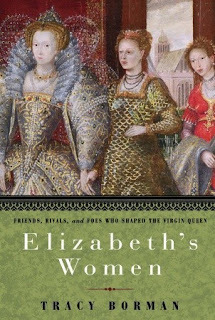
Some armchair critics have overlooked the immense task Tracy Borman undertook and successfully completed in writing and getting this published. In a literary avalanche of popular Tudor history dominated by old masters and current favourites, this comparatively unknown writer braved something extraordinary.
Like others, I turned to this after exhausting dozens of biographies on the key Tudor players and their epoch. We must keep our expectations realistic - as with any such addictive material, there is only a finite euphoric altitude we can maintain before desensitisation to the fix itself sets in. No use hammering away wanting the earth to move page after page so far into any such study (we can perhaps reasonably assume that few absolute beginners would turn to this particular title for introductions to the reign). These things considered, it's also impossible not to draw comparisons.
With voices like Alison Weir (and Antonia Fraser, if not specifically on this subject, then characterising the genre itself) to compete with, one has to wonder how others conjure up the confidence to even begin. What makes popular historians popular is not just their detail and accuracy but their voices (some of the most meticulously researched, accurately presented history published is dry, soulless and unreadable).
Borman holds her own voice-wise, here. It may be interesting to compare her progress after twenty, thirty, forty years (Fraser, for example, already had her distinctively sumptuous, compassionate style down pat by the time of her 1969 Mary, Queen of Scots and, while perhaps growing technically and conceptually since, has preserved what made her successful: it's not so much what she says but the way that she says it!
Similarly, Alison Weir had her own defining style to begin with - with perhaps more emphasis on impressive citation and indexing that made her stand out from others.
There are countless others. Carolly Erickson, Alison Plowden, David Starkey, David Loades, Eric Ives, the list is as long as it is diverse, all riding high on stylistic hallmarking rather than just breaking even on factualist or conceptualist calibre alone.
Tracy Borman is yet to demonstrate any such characteristic consistency across any substantial body of published work. She has made a commendable start though and this book deserves its rightful place on any good Elizabethan historian's shelf.
Though each of Elizabeth's women discussed have been well covered before in greater detail, they are here effectively assembled in a unique and stimulating formation. Context is key, with each woman's positioning seemingly bearing particular relevance on the defining of Gloriana herself.
Great concept. Well written. Will definitely consider reading more of this author's fine work.
My review of The Other Boleyn Girl, by Philippa Gregory
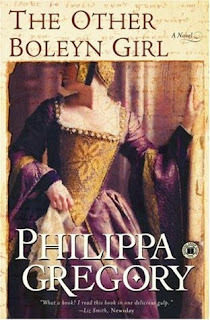
The 2008 movie, starring Natalie Portman and Scarlett Johansson, made this title familiar to many who would not otherwise have read the book. That mass publicity was a double-edged sword, with the movie receiving mixed reviews and criticism for historical inaccuracy. Indeed, the novel too suffered some disputed historical accuracy but has far greater subtlety and creative licence.
While Philippa Gregory's novel makes requisite use of fictional elements, the film took it to extremes, discrediting the book it promoted. Though Gregory need perhaps not concern herself now, with the global success of her subsequent novels, the debacle must then have been tough for this talented, hardworking author. Certain historical details of this tale are black and white, others grey:
Earlier historians claimed Elizabeth I's maternal aunt, Mary Boleyn, was Queen Anne's younger sister, but her children believed she was the elder, as does a growing consensus of today's historians. Regardless, legend strongly suggests Mary was thought the more beautiful of the two Boleyn sisters, going by aesthetic ideals of the day. With no less scandalous a public record than her beheaded sister Anne, poor Mary has undoubtedly been as much a victim of malicious press as Anne has been a victim of political propaganda.
A rumoured mistress of King Francis I of France, some historians believe tales of Mary's promiscuity exaggerated, while others deem them plainly apocryphal. King Francis's harsh reference to her as 'The English Mare', 'my hackney' and 'una grandissima ribalda, infame sopra tutte' ('a great slag, infamous above all), may have been merely sour grapes after a more innocently romantic public liaison: she did, after all, leave Francis and his court, and his hearing of her subsequent high profile amours could have simply bruised his royal pride.
When Mary returned to England in 1519, she was appointed a maid-of-honour to Catherine of Aragon, queen consort of Henry VIII. She then became Henry VIII's mistress from around 1521 to 1526. After later marrying wealthy and influential courtier William Carey, she was left widowed then secretly remarried for love to William Stafford, a lowly soldier considered beneath her aristocratic rank. This latter choice resulted in her banishment from court, and she spent the rest of her life in obscurity, dying in her early forties in 1543, seven years after Anne Boleyn's execution.
Many preferred this earlier Philippa Gregory book over her later one, The White Queen. This subject certainly holds more popular appeal, but to me that does not equal a better book.
Gregory's greater challenge was surely always going to be The White Queen, as readers are less familiar with that (infinitely more complex) history than with this story and its principal characters. Therefore, Gregory's greater achievement of those two is, in my opinion, the one which presented the harder challenge, The White Queen.
I nonetheless equally liked this, which makes for the more gripping read, its character list tighter and more focused than The White Queen's convoluted ensemble (that, I believe, is why some rubbished the latter, because they found it harder to follow due to their own lack of knowledge).
The Other Boleyn Girl is a good read by a classy, accomplished writer. Its sequel novel, The Boleyn Inheritance, tells the story of Anne of Cleves, Catherine Howard and Jane (Parker) Boleyn.
I like everything of Philippa Gregory's I have so far read.
My review of The White Queen, by Philippa Gregory
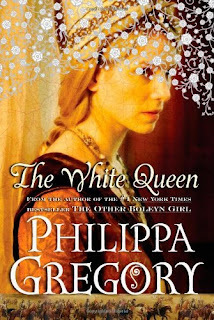
I read this novel having exhausted much of the definitive fictional and non-fictional work on my favourite periods. Not my all-time favourite epoch, the more I read on the Wars of the Roses the more interested I become.
The White Queen is the first in Philippa Gregory's series The Cousins' War about the female figures of those 'wars' fought between 1455 and 1487 (with related fighting before and after).
This novel's title refers to Elizabeth Woodville who, as Sir John Grey's widow, was thought to have used occult powers to seduce King Edward IV, becoming his queen and widow. The legendary mystery of her little sons, the Princes in the Tower, is examined, and whether King Richard III had them killed.
Heavily featured is Anne Neville, Warwick the Kingmaker's daughter who will marry Richard III, briefly becoming Queen of England.
We also follow Margaret Beaufort, whose son Henry Tudor will marry Elizabeth Woodville's daughter, founding his famous royal dynasty.
Whilst this makes no pretence of targeting the intelligentsia, it never stoops as low as hardline history pedants may presuppose. Gregory is first an historian and secondly a novelist. Accuracy to fine detail and meticulous research is evidently paramount, though without compromising literary calibre. That more than suffices for some reading purposes. Non-fiction histories of our less favourite periods can err on the dry side.
If I want to read a great novelist I will. Likewise with a great academic historian. But for deepening my familiarity with such a convoluted and not especially gripping episode, I prefer an accomplished historian who can fictionalise engagingly - not simply either a dashing literary wordsmith or a formidable date-spouting egghead.
If we had Proust, Dostoyevsky, Hugo or Virginia Wolf writing on this topic they would lack the specialised knowledge required of it. To make such a book work it must be done by an historian rather than a novelist. Imagine Barbara Cartland, the most read romance novelist, attempting this? Then again, would we really sit pigheadedly yawning through some dry, dusty old textbook purely for bare factuality's sake?
This genre therefore sits legitimately on the educational spectrum, veiled in a tissue of that popular sweetener: romantic spin. That was what I sought on this occasion and was what I found. I usually keep my literary fiction in one box and my historical fiction and non-fiction in two others. Expecting both combined can be unrealistic.
This is an impressively substantial, satisfying read by a woman who knows her material and was clearly aiming also for a popular TV spin-off. That eventuating ten-part 2013 BBC adaptation was said to have had, like so many of its genre, a cheapening effect, receiving mixed to negative reviews. Ms. Gregory would have nonetheless laughed all the way to the bank.
Although I tend to read more non-fiction history, skipping straight to the facts, this fictional piece marked a well-earned break from my borderline stuffy convention. Good for Philippa Gregory and may she reap all riches she's worked so hard for.
My review of Henry: Virtuous Prince, by David Starkey
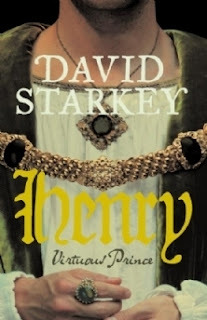
Being one of the more recent Henry VIII biographies, and being specifically about Henry's youth, this was a popular choice when widespread interest became fuelled by 'that' TV series with Jonathan Rhys Meyers. I checked it for comparison with the 5 others I've read on Henry.
I rate it on par with the good ones for dynastic background and incidental (impersonal) detail, but not for character study. If more drily and stuffily presented than personally accessible, this is academically fine and faultless in its fine detail.
Not the first Starkey biography I've read, this is his pet dynasty. He specialised in Tudor history at Cambridge, writing a thesis on Henry VIII's household. His knowledge, as would be expected, is impressive, while his reader-connection is standoffish. This makes for a drier, less authentic result than I seek in any biography.
Focusing on young Henry rather than his life, this might have been a more personal look at the 'spare' heir whose apparent destiny changed course for the better with the death of his older brother Arthur. No matter how meticulously researched and presented, personal supply inventories and monetary accounts do not suffice, in my mind, as 'personalisation'. Rather, a more intimate style of penmanship than Starkey's is the key.
While, admittedly, generalisations can be invalid, the notary female historical biographers I've read (mostly, not all) have achieved more evocative results than their male contemporaries. Such women have been criticised for being overly emotive in approach and Starkey seems to be making a point around this in his own more remote, albeit supremely erudite, style. If, like me, you like blood pumped into a study's cheeks, tones given to their voice, rationale explained around their more private decisions, then Starkey disappoints.
Only fair to consider that the 'heart and soul' we might be prospecting for in this has been reaped over and over from Starkey's most formidable biographical predecessors - there was no point in his aiming to replicate, but rather to find an original take on this weightily covered topic. In this unenviable task he succeeds, leaving his own hallmark on the vastly sprawling genre of Tudor biography.
This slightly prickly addition to any Tudor reading shelf will contribute balance and sophistication.
My review of Henry VIII: The King and His Court, by Alison Weir

I love most of Alison Weir's work and this is no exception.
The research is astonishing. The clothes, décor and meals of England's infamous catalyst-king of the reformation, his court and his six wives are wondrously detailed.
The journey of the golden-haired boy, the meaty young lion and the obese, middle-aged tyrant is sumptuously charted. His gargantuan ego and delicate insecurities are thoroughly fleshed out. The human side of 'God's anointed' is sensitively examined.
The extremes he went to for a legitimate male heir were steered by the notion that his daughters would be unable to sustain his father Henry VII's fragile new dynasty (established not by laws of primogeniture but by triumphing in the Wars of the Roses).
Great Harry's struggles with Rome over his insistence on discarding Queen Catherine to marry Anne Boleyn led to the severance of the Church of England from papal authority and the Dissolution of the Monasteries. As the first ruling Supreme Head of the Church of England, he remained a believer in Catholic teachings even after his excommunication from the Roman Catholic Church.
Though Henry VIII has often been depicted as a lustful, insecure tyrant, this is probably not the full picture. His contemporaries considered him in his prime to be attractive, educated and accomplished. Also an author and composer, he has been described as 'one of the most charismatic rulers to sit on the English throne'.
He became obese in later years. With a 54-inch waist, he required mobilisation by mechanical inventions. He probably suffered from gout and was famously covered with insufferable, stinking, pus-filled boils. His obesity and other illnesses went back to a jousting accident in 1536, in which he suffered a leg wound. All these ailments hastened his death at 55, in 1547, at Whitehall Palace.
He was succeeded by his son, the boy king Edward VI, who died at 16, making way for Henry's older daughter 'Bloody' Mary I. She lived only five years on the throne. Henry's younger daughter, Elizabeth I, was the last Tudor, whose forty-four-year reign brought England stability, helping forge its sense of national identity.
Alison Weir's superb biography explores Henry VIII's legacy and the reasons his magnificent offspring turned out as they did. Had Henry been a different man, history might have unfolded differently and today's English-speaking world would probably not be as we know it.
This masterpiece is to be slowly and thoroughly pondered in brief, leisurely sessions, sleepy weekends or long, late nights. It's as thick as a brick and worth a hundred times its retail value.
My review of Bloody Mary: The Life of Mary Tudor, by Carolly Erickson
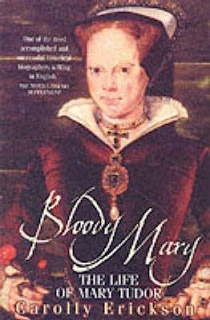
A terrific biography of a much maligned and grossly misunderstood historical figure, a scapegoat for generations of vicious religious and political propagandists.
Though she burned and persecuted 'heretics', so did most European monarchs of her era, Catholic and Protestant.
After a splendid start in life, Henry VIII's half-Spanish, half-English heir to the English throne was treated cruelly and heartlessly throughout her youth because of her genes, her gender and her parents' reformation-triggering marriage annulment.
Her mother Catherine of Aragon was her only close ally, but King Henry eventually forbade mother and daughter contact. Her younger cousin-husband Prince Phillip of Spain, who she adored, would treat her little better than her father had.
Her maltreatment, heartache over her parents' unprecedented marriage annulment, her humiliation of being for a time displaced from the succession for her 'bastard' stepsister, Elizabeth, plus Mary's archly devout piousness in a changing religious milieu explains much about this tortured soul.
This granddaughter of Queen Isabella I of Castile and King Ferdinand II of Aragon become a marvellously tragic, at times right royal neurotic.
Despite this and, seemingly possessing the mother of all death stares (she was actually vision impaired), the chronically misrepresented Mary Tudor had the heart and makings of a great anointed queen. History might have treated her more favourably had she had more time to establish herself rather than dying so prematurely - some said of a broken heart - just a few years after ascending the throne.
Her poignant tale is told with compassion and aplomb. Erudite and humane, Carolly Erickson pumps blood into Mary's veins like no other biographer, without apology for the monarch's infamous personal shortcomings.
An enlightening tragedy that peels away the cobwebs of centuries, leaving the reader relieved to live in today's world and historically informed.
My review of The Life of Elizabeth I, by Alison Weir
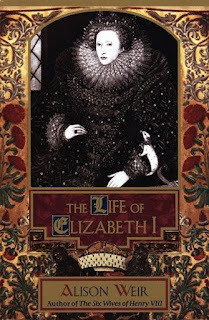
Published outside America as Elizabeth the Queen, this is my favourite biography of my favourite historical figure - and I've read almost every one published - by the UK's highest-selling female historian.
Alison Weir's detail and quality closely rival the great Antonia Fraser who, before Weir in an earlier decade, wrote the now definitive work on Elizabeth's great adversary, Mary Queen of Scots, my next favourite historical figure.
With her mother, Anne Boleyn, executed when Elizabeth was two, and her parents' marriage annulled, she was declared illegitimate. At twenty-five this dogged survivor succeeded her half-sister 'Bloody Mary', who had imprisoned Elizabeth for almost a year on suspicion of supporting Protestant rebels.
Tagged the 'Virgin Queen', Elizabeth considered herself married to England, never settling on a groom when any choice of foreign prince could have worked politically against her favour. Her true great love, Robert Dudley 'the Gypsy', was beneath her in rank, of famously treasonous stock and of dubious public renown after the mysterious death of his wife Amy.
More moderate a ruler than her father and half-siblings, one of her mottoes was 'video et taceo' ('I see, and say nothing'). Her Religious Settlement evolved into today's Church of England. Her eponymous age saw English drama flourish, led by Shakespeare and Marlowe, with seamen like Francis Drake knighted as heroes.
Her forty-four-year reign, for many years politically shaky after she was branded a heretic by the pope, eventually brought England stability, helping forge its sense of national identity.
Renowned by detractors as short-tempered and indecisive, Elizabeth was also famously charming and no flibbertigibbet. On the contrary, she was a wily mistress of prevarication. Blessed with the 'common touch' she was hugely popular with her subjects, nicknamed 'Good Queen Bess' and 'Gloriana'.
The Spanish Armada's failure associated her with one of English history's greatest military victories. Her Tilbury speech to the troops, delivered wearing a silver breastplate over a white velvet dress, is legendary.
Whilst Weir's writing has been derided as 'popular history', the jealousy underlying such professional jibing is plainly evident. The Guardian's Kathryn Hughes wrote in 2005: 'To describe her as a popular historian would be to state a literal truth – her chunky explorations of Britain's early modern past sell in the kind of multiples that others can only dream of.'
In her website's Author Biography, Weir graciously shuns the derogatory connotation behind 'popular historian', remarking eloquently:
'History is not the sole preserve of academics. Although I have the utmost respect for those historians who undertake new research and contribute something new to our knowledge. History belongs to us all, and it can be accessed by us all. And if writing it in a way that is accessible and entertaining, as well as conscientiously researched, can be described as popular, then, yes, I am a popular historian, and am proud and happy to be one.'
This book is as thick as a brick, supremely informative and worth infinitely more than its considerable retail value. Kept me up burning the midnight oil for weeks. I reread it two years later, loving it just as much. Well worth the lost sleep. Can't praise it highly enough.



